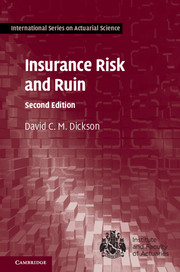Book contents
- Frontmatter
- Dedication
- Contents
- Preface
- 1 Probability Distributions and Insurance Applications
- 2 Utility Theory
- 3 Principles of Premium Calculation
- 4 The Collective Risk Model
- 5 The Individual Risk Model
- 6 Introduction to Ruin Theory
- 7 Classical Ruin Theory
- 8 Advanced Ruin Theory
- 9 Reinsurance
- Appendix
- Solutions to Exercises
- References
- Index
6 - Introduction to Ruin Theory
Published online by Cambridge University Press: 17 November 2016
- Frontmatter
- Dedication
- Contents
- Preface
- 1 Probability Distributions and Insurance Applications
- 2 Utility Theory
- 3 Principles of Premium Calculation
- 4 The Collective Risk Model
- 5 The Individual Risk Model
- 6 Introduction to Ruin Theory
- 7 Classical Ruin Theory
- 8 Advanced Ruin Theory
- 9 Reinsurance
- Appendix
- Solutions to Exercises
- References
- Index
Summary
Introduction
Ruin theory is motivated by the practical issue of solvency. Solvency is a complicated topic, but in simple terms an insurance company could be described as being solvent if it has sufficient assets to meet its liabilities. This statement is somewhat vague, and in practice it is common for a level of solvency to be set by an insurance regulator. For example, a regulator might stipulate that with a suitably high probability, say 0.99, an insurance company can meet its liabilities over a specified time horizon.
Ruin theory is concerned with the level of an insurer's surplus for a portfolio of insurance policies. In Chapter 4 we considered the aggregate amount of claims paid out in a single time period. We now consider the evolution of an insurance fund over time, taking account of the times at which claims occur, as well as their amounts. To make our study mathematically tractable, we simplify a real life insurance operation by assuming that the insurer starts with some non-negative amount of money, collects premiums and pays claims as they occur. Our model of an insurance surplus process is thus deemed to have three components: initial surplus (or surplus at time zero), premiums received and claims paid. For the model discussed in this chapter, if the insurer's surplus falls to zero or below, we say that ruin occurs.
The aim of this chapter is to provide an introduction to the ideas of ruin theory, in particular probabilistic arguments. We use a discrete time model to introduce ideas that we apply in the next two chapters where we consider a continuous time model. Indeed, we will meet analogues of results given in this chapter in these two chapters. We start in the next section by describing our model, then in Section 6.3 we derive a general equation for the probability of ruin in an infinite time horizon, and consider situations in which it is possible to obtain an explicit solution for this probability.We then consider the probability of ruin in a finite time horizon in Section 6.4, while in Section 6.5 we prove Lundberg's inequality, which is one of the most famous results in risk theory.
- Type
- Chapter
- Information
- Insurance Risk and Ruin , pp. 114 - 126Publisher: Cambridge University PressPrint publication year: 2016
- 1
- Cited by



